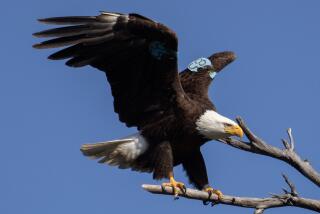Lack of Food May Have Hurt Bald Eagle in Northeast
- Share via
WASHINGTON — New research suggests that bald eagles may have been as abundant along the Northeast coast in 18th-Century America as they now are along the relatively pristine Pacific Northwest coast from Vancouver to Alaska.
Andrew J. Hansen, formerly a visiting researcher at the Oak Ridge National Laboratory in Tennessee, believes a shortage of food and good nesting sites may have contributed to the decline of the bald eagle in the United States. Scientists had blamed hunting and the pesticide DDT for nearly wiping out bald eagles in most of the United States.
Writing in the October issue of the journal Ecology, Hansen said some lucky “natural experiments” in Alaska tipped him off to the importance of food supply to the species that is listed as endangered in 43 states.
Hansen observed that in two years of a four-year study of nesting eagles, there were big increases in food available to eagles when large numbers of salmon carcasses, frozen in the Chilkat River during winter spawning, thawed out of the ice in spring as the birds were beginning to lay eggs. Hansen said the food patches attracted about 250 eagles to the area.
During the two years with this bonus food, Hansen observed eagles incubating eggs earlier and in a higher percentage of nests in the area. Observing the nests from a helicopter, Hansen also found active nests were clustered around the 1.3-mile-long fish patches during these years but evenly spread out along the river in other years.
The observation lead him to conduct his own experiment with the eagles in 1983. He put extra food on gravel bars in the river near sites where he observed eagles nesting. He then compared the number of chicks raised by these birds to the number raised by birds that did not get any supplemental salmon.
Hansen found that four of 12 chicks from families that got the handouts survived but that just two of 48 chicks in other nests survived.
He believes the poor success of the unfed birds was “because abundant food in spring allowed high breeding rates but subsequent food shortages caused widespread starvation among eaglets.”
The scientist also observed that a nest’s location seemed to be important to breeding. He found that eagles that were incubating eggs occupied nests in taller trees that projected above the forest canopy. Nests in shorter trees, hidden down in the canopy, were more often “inactive,” or occupied by non-breeding eagles.
Could Better Spot Prey
Hansen reasoned that the eagles in high nests had a better vantage point for spotting prey. He said having a good, steady food supply close to the nest was a key to successful breeding.
“The ephemeral food supplies of the Pacific Northwest coast may allow more eagles to survive than can reproduce,” he wrote. “Non-breeding eagles can wander extensively and utilize dispersed food patches, but breeders must forage close to their nests.”
Hansen goes on to speculate that “eagles were as abundant in some other locations in North America during presettlement times as they are along the Pacific Northwest coast today.”
He pointed out that before settlement, Atlantic salmon, alewives and American shad were abundant along the Northeast coast. Overfishing and logging destroyed the food and habitat that could have supported larger numbers of eagles, he said.
In addition, Hansen said, hunting of the birds in the 19th and early 20th centuries and use of the pesticide DDT, introduced in 1942, further accelerated the decline of the endangered species.
DDT was banned in 1972 because of its effects on wildlife. It caused eagles to lay eggs with fatally thin shells and is widely blamed for the near-extinction of the bird in some parts of the country.
Historical Evidence
Hansen is the first scientist to report that experimental food supplements can increase chick survival for large birds of prey, and he believes that wildlife managers may be able to use this to nurse along the recovery of eagle populations.
Curtice Griffin, assistant professor of wildlife biology at the University of Massachusetts, said historic evidence from New York and New Jersey supports the idea that there may have been coastal eagle populations there and north through New England.
He said Hansen’s findings could “prove to be a very valuable management tool” for bringing back eagle populations.
Mark McCollough, a wildlife biologist at the University of Maine who, like Hansen, did his doctoral research on bald eagles, was more doubtful that feeding could improve reproduction of East Coast eagles.
He said there may already be sufficient natural food available to the smaller populations of eagles which he said had much higher rates of reproduction than Hansen found for the Alaskan eagles.
He said food supplements over winter might help keep more young, non-breeding eagles alive.
McCollough agreed that well before the DDT disaster, East Coast eagle populations were decimated by clearing of tall pine trees and the decline of river-spawning marine fish.
More to Read
Sign up for Essential California
The most important California stories and recommendations in your inbox every morning.
You may occasionally receive promotional content from the Los Angeles Times.













